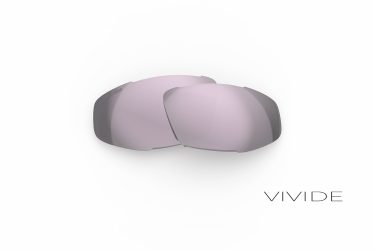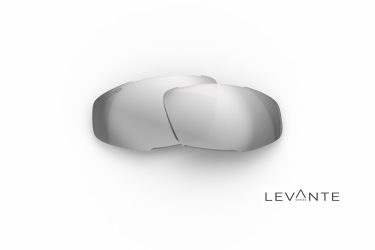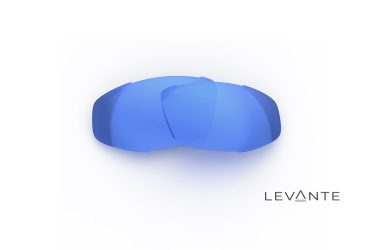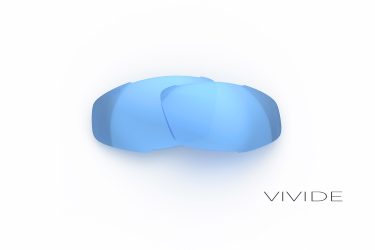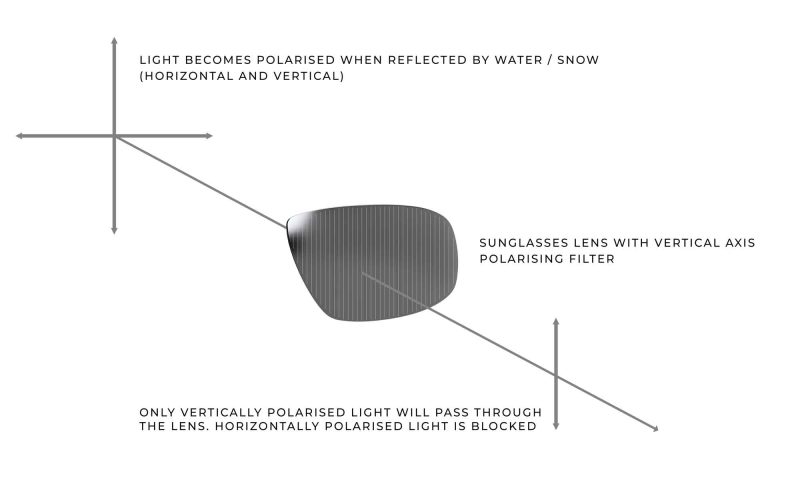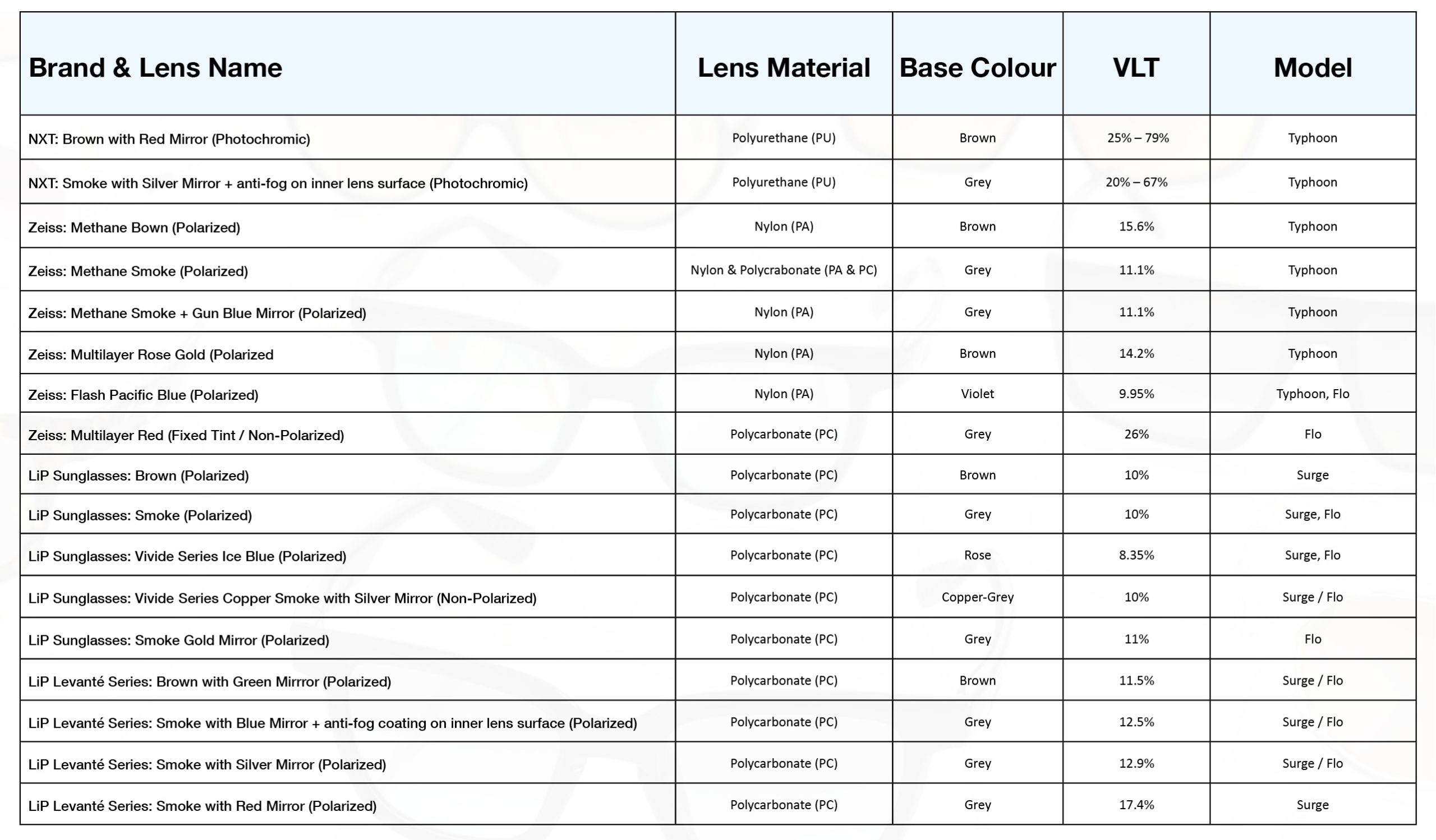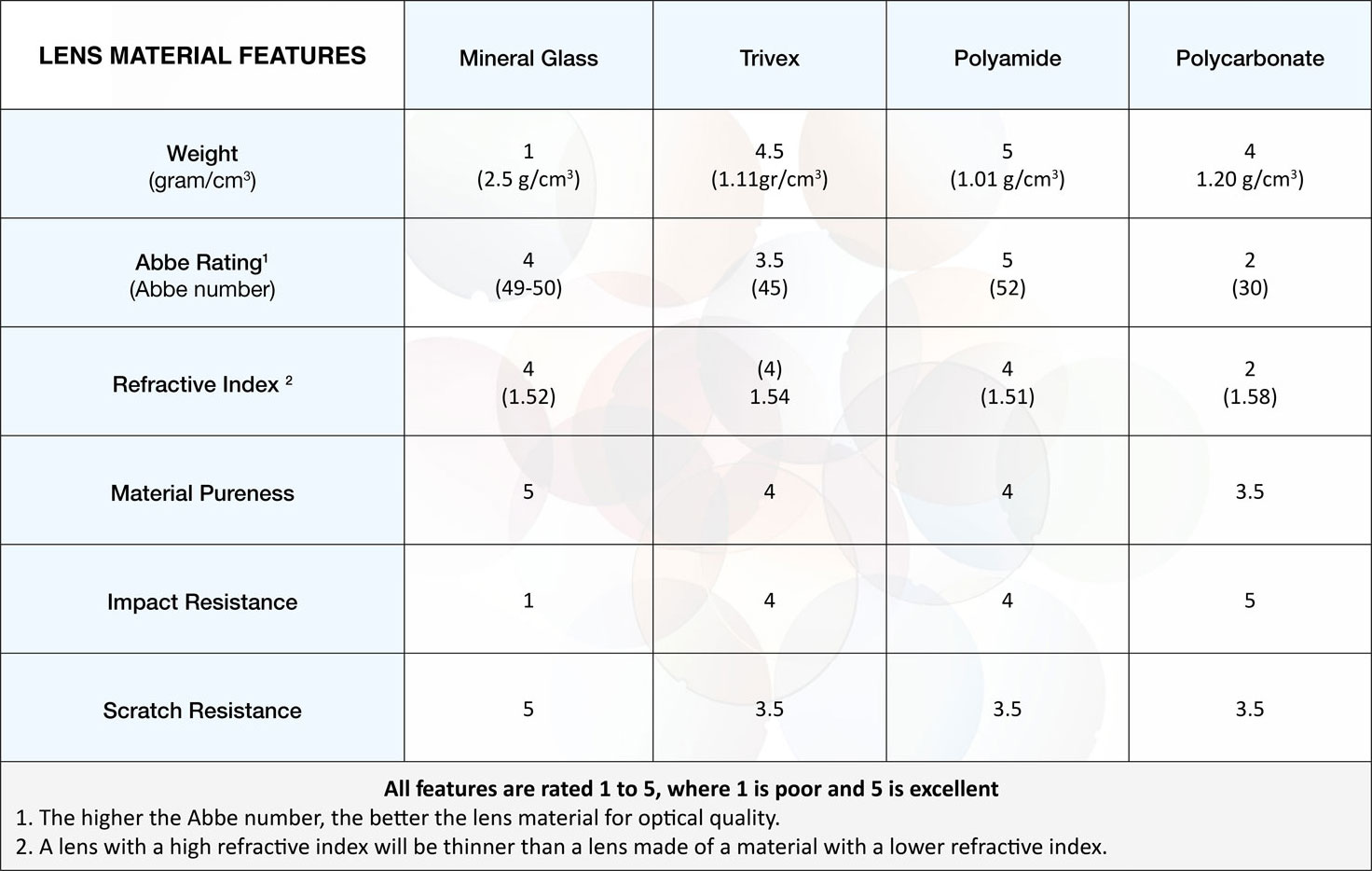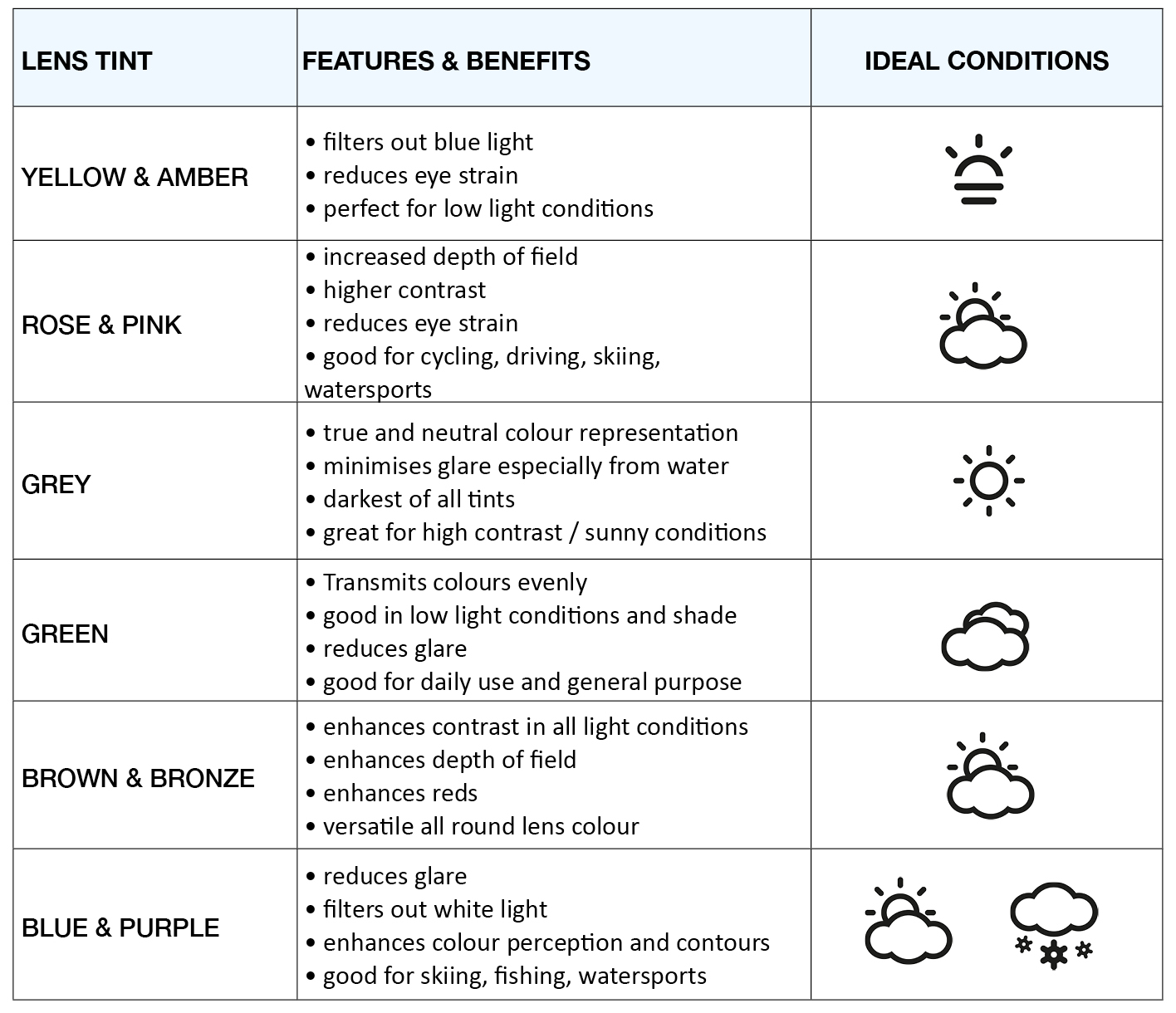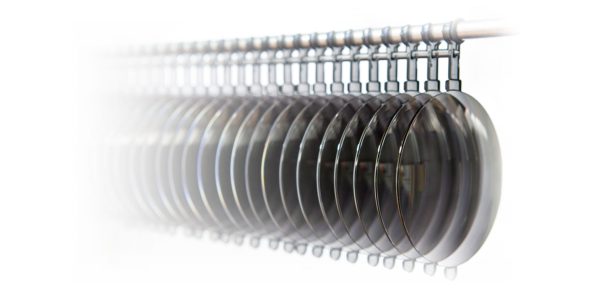
Lenses
While UV protection is the primary reason we wear sunglasses, watersports environments demand more. Quality lenses also safeguard against impact and cut through glare from surface reflections. Premium watersports lenses go beyond basic UV protection – their advanced filtering technologies dramatically enhance visual clarity and comfort on the water.
UV Blocking
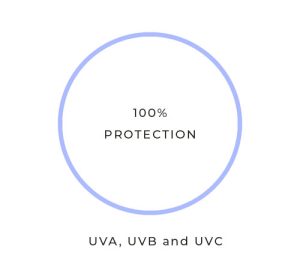
UV blocking sunglasses lenses offer optimal eye protection, significantly reducing the risks from UV exposure. Like sunscreen, they should be worn as soon as you are outside, even on hazy / cloudy days as clouds do not block UV rays and surfaces like water, sand and buildings reflect it.
Impact Resistant
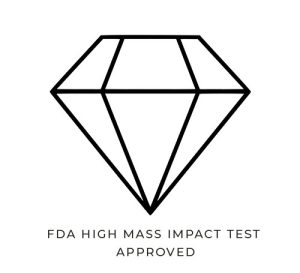
The FDA regulates eyewear products to ensure their safety credentials. Impact resistance is an essential criterion that is subject to standardisation and testing regimes. All our lenses comply with the FDA’s ‘drop ball test’ and comply with ANSI and other international standards authorities.
The lenses are the heart of any sunglasses and here we make no compromises, cooperating only with leading manufacturers. All of our lenses are developed and produced under rigorous quality control and applied with a number of special performance coatings in order to enhance visibility, repel water & dirt, and increase scratch resistance and durability. A range of mirror coatings are available for a stylish finish. Jump to a section by clicking a button below.
Lenses by ZEiSS
FOR TYPHOON & FLO
Here we provide a summary of Zeiss lenses used in our Typhoon and Flo models.

Photochromic Smoke Silver Mirror (TYPHOON)
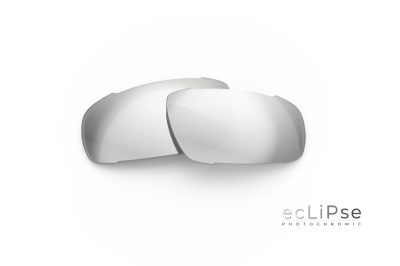
Our ecLiPse Series Photochromic lenses come equipped with a smoke base colour with a light silver mirror coating on the front and an anti-fog coating on the rear surface. Available in the Surge, Typhoon and FLO models, these lenses offer a neutral tone, and are a category 1-3 polycarbonate lens. The photochromic element is activated by UV and the tint adjustment period is 15-20 seconds. The VLT (visible light transmission) range is 14% to 52%. At these VLT levels, the lenses will be able to handle a wide range of lighting conditions from bright sunshine to cloudy skies, and are an ideal lens for the winter months or if you need something for changeable conditions. Equipped with an advanced hydrophobic coating to repel water, an anti-smudge oleophobic coating and a hard coating on the front surface and an anti-fog and hard coat on the rear surface.
Anti-fog?
Material
Base Colour
VLT
Availability: In stock

Zeiss Violet Super Blue (TYPHOON)

Available only in the Typhoon model, this nylon lens is suited to bright and very bright conditions. As the visible light transmission (11.8%) is 2% higher than the transmission rate for the Pacific Blue lenses – the Super Blue lens performs a little better in lower light conditions. These lenses subdue the amount of blue light entering the eye and enhance reds and greens. The mirror coating also reflects some blue light. A good stylistic alternative to the Pacific Blue lenses if you prefer a lighter blue mirror coating and a little more brightness in the field of view. Equipped with Zeiss’s advanced hydrophobic coating to repel water, an anti-smudge oleophobic coating and a hard coating on both sides of the lenses.
Anti-fog?
Material
Base Colour
VLT
Availability: In stock

NXT Photochromic Smoke (TYPHOON)
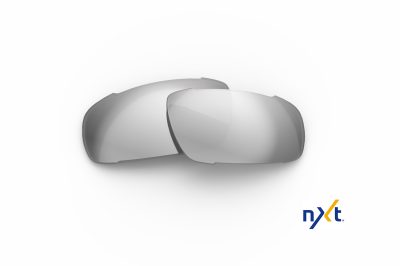
Our ecLiPse photochromic smoke lenses offer a versatile solution for days when the weather and lighting conditions are changeable. The tint of these lenses adapts to changes in visible light, ranging from 45% when light levels are low to 15% in sunny conditions. The base colour is grey which offers a neutral tone. Note that photochromic lenses do not cut out reflected glare – only polarized lenses can achieve this. As with all our watershades lenses, these lenses come equipped with an advanced hydrophobic coating to repel water, an anti-smudge oleophobic coating and a hard coating on both inner and outer lens surfaces.
Anti-fog?
Material
Base Colour
VLT
Availability: In stock

Photochromic Brown Red Mirror (TYPHOON)
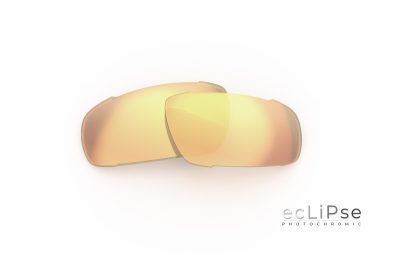
Our ecLiPse Series photochromic lenses with a brown base colour with a red mirror coating come into their own when the clouds roll in and are ideal for changeable winter and spring weather conditions. As with all of our photochromic lenses, the tint of these lenses adapts to changes in UV levels, ranging from 74% when UV levels are low to 19% when the sun emerges from behind the clouds. With a rapid activation and deactivation speed of 20-25 seconds irrespective of temperature, they offer a versatile solution for difficult lighting conditions. They come equipped with an advanced hydrophobic coating, oleophobic and hard coatings on both inner and outer lens surfaces.
Anti-fog?
Material
Base Colour
VLT
Availability: In stock

Zeiss Methane Brown (TYPHOON)
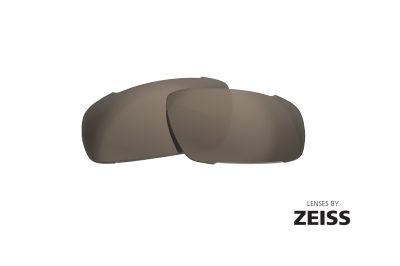
A Category 3 polarized lens with a brown base colour, our Methane Brown lenses lift or ‘pop’ all colours (but especially reds and greens). This in turn increases contrast and reduces eye fatigue. With a VLT of 15.6% (the highest VLT rate of our polarized Zeiss lenses for the Typhoon) they can be used in all conditions, however there is a noticeable difference in performance in cloudy or changeable lighting conditions. The 'Methane' refers to a very subtle silver sheen applied on top of the base lens for a touch of style. Equipped with an advanced hydrophobic coating to repel water, an anti-smudge oleophobic coating and a hard coating on both sides of the lenses.
Anti-fog?
Material
Base Colour
VLT
Availability: In stock

Zeiss Violet Pacific Blue (TYPHOON)

The violet base colour of the Pacific Blue lenses by ZEISS provide enhanced contrast and vivid colour perception. The violet base colour subdues the amount of blue light entering the eye and enhance the reds and greens – offering a HD visual experience. These category 3 polarised lenses are perfect for very bright conditions in environments with deep blue ocean colours like the Pacific or Atlantic. The VLT is 9.95% which is at the lower end of a Category 3 lens and so they are perfectly suited to really bright and sunny conditions. They come equipped with Zeiss’s advanced hydrophobic coating to repel water, an anti-smudge oleophobic coating and a hard coating on both sides of the lenses.
Anti-fog?
Material
Base Colour
VLT
Availability: In stock

Zeiss Brown Rose Gold (TYPHOON)

The Rose Gold nylon lenses have a brown base lens colour which is coupled with a rose gold mirror coating. The brown base lens colour offers great contrast and also contributes to a reduction of eye fatigue. The VLT rate for these lenses is 14.2% which while still squarely within the Category 3 range, is a bit higher than most of our other Zeiss lenses which fall in the 9-12% range. This lens is therefore well equipped for lower light conditions and cloudier days, but may not be the perfect choice for super-bright sunny conditions. They come equipped with Zeiss’s advanced hydrophobic coating to repel water, an anti-smudge oleophobic coating and a hard coating on both sides of the lenses.
Anti-fog?
Material
Base Colour
VLT
Availability: In stock

Zeiss Methane Smoke (TYPHOON)

The Methane Smoke Category 3 nylon lenses by Zeiss offer a neutral tone. If you prefer a natural representation of colours or you have sensitive eyes, this is very likely the lens for you. They have a VLT rate of 11.1% which means that they are designed for bright & sunny environments. At this VLT level, the lenses will be able to handle strong sunlight and significant glare. However, for cloudy days and sessions when the sun is well on its way down, they may be a little on the dark side. They are equipped with an advanced hydrophobic coating to repel water, an anti-smudge oleophobic coating and a hard coating on both sides of the lenses.
Anti-fog?
Material
Base Colour
VLT
Availability: In stock
An explanation of the terms ‘Tri-Pel’ and ‘Ri-Pel’ is given below in the section ‘Tri-Pel and Ri-Pel coatings by Zeiss’.
International Standards
All LiP sunglasses lenses comply with the following standards:
- European Standard EN ISO 12312-1:2013
- American National Standard ANSI Z80.3-2018
- Australian/New Zealand Standard AS/NZS 1067.1.2016
- ANSI Z87.1-2003 (High Mass Impact Test)
Lenses by LiP Sunglasses
FOR SURGE & FLO
Here we provide a summary of Levanté, VIVIDE and ecLiPse series lenses used in our Surge and Flo models.

Photochromic Brown Red Mirror (SURGE)
Our ecLiPse™ Series Photochromic brown lenses come equipped with a multilayer red mirror coating on the front and Tri-Pro coating on both the front and rear lens surfaces. Available in the Surge, Typhoon and FLO models, these lenses offer a neutral tone, and are a category 1-2 polycarbonate lens. The photochromic element is activated by UV and the tint activation period is 20-25 seconds. The VLT (visible light transmission) range is 19% to 74%. With these VLT levels, the lenses are ideal for cloudy / low light conditions, but can also handle moderately bright conditions. They are an ideal lens for the winter months or if you need something for low light conditions. Equipped with an advanced hydrophobic coating to repel water, an anti-smudge oleophobic coating to repel dirt and oil and a hard coating on both the front and rear surfaces.
Anti-fog?
Material
Base Colour
VLT
Availability: In stock

Photochromic Smoke Silver Mirror (SURGE)
Our ecLiPse Series Photochromic smoke lenses come equipped with a light silver mirror coating on the front and an anti-fog coating on the rear surface. Available in the Surge, Typhoon and FLO models, these lenses offer a neutral tone, and are a category 1-3 polycarbonate lens. The photochromic element is activated by UV and the tint adjustment period is 20-25 seconds. The VLT (visible light transmission) range is 14% to 52%. At these VLT levels, the lenses will be able to handle a wide range of lighting conditions from bright sunshine to cloudy skies, and are an ideal lens for the winter months or if you need something for changeable conditions. Equipped with an advanced hydrophobic coating to repel water, an anti-smudge oleophobic coating and a hard coating on the front surface and an anti-fog and hard coat on the rear surface.
Anti-fog?
Material
Base Colour
VLT
Availability: In stock

Chroma Smoke (SURGE)
The Chroma Smoke (grey) polycarbonate lenses for the Surge and FLO offer a neutral tone, and are a category 3 polarized lens. If you like a natural representation of colours, then this is the lens for you. The VLT (visible light transmission) is 10.2%. At these VLT levels, the lenses will be able to handle very bright sunlight and significant glare. However, for cloudy days and sessions when the sun is well on its way down, they may be a little on the dark side when it comes to the end of the day. Equipped with an advanced hydrophobic coating to repel water, an anti-smudge oleophobic coating and a hard coating on both sides of the lenses.
Anti-fog?
Material
Base Colour
VLT
Availability: In stock

Copper Smoke Silver Mirror (SURGE)
These polycarbonate VIVIDE Series lenses by LiP Sunglasses have a blended copper-grey base colour and a uniform silver mirror coating. The copper-grey base colour enhances reds and greens, while the uniform flash mirror coating cuts out some of the glare. With a VLT rate of 10%, these lenses are at the darker end of Category 3 lenses and are ideal for very bright cloudless skies. However, as these lenses are not polarized, reflected glare is not significantly filtered out so these lenses may not be ideal if you are looking for lenses that remove glare. They are however excellent for reading the water and wind lines. Equipped with an advanced hydrophobic coating to repel water, an anti-smudge oleophobic coating and a hard coating on both sides of the lenses.
Anti-fog?
Material
Base Colour
VLT
Availability: In stock

Smoke Silver Mirror (SURGE)
These polycarbonate Levanté Series lenses by LiP Sunglasses have a grey base colour and a uniform silver mirror coating for a low-key aesthetic finish. The grey base colour has a neutral tone and the VLT rate is 12.9% – which is a good all round tint for bright and sunny conditions, and are a little lighter than the Chroma Smoke lenses if you are likely to experience intermittent clouds. As with all of our lenses, there is 100% UV protection. They are equipped with an advanced hydrophobic coating, anti-smudge oleophobic coating and hard coating on both sides of the lenses.
Anti-fog?
Material
Base Colour
VLT
Availability: In stock

Smoke Multilayer Blue (SURGE)
These polycarbonate Levanté Series lenses by LiP Sunglasses have a grey base colour and a multilayer blue mirror coating. They are also equipped with an anti-fog coating on the inner lens surface. The anti-fog coating is designed to defog lenses that become foggy due to body heat / moist exhaled breath so this lens is ideal for beginners that spend as much time in the water as on it. The grey base colour has a neutral tone and the VLT rate is 12.5% – which is a good all round tint for bright and sunny conditions. With 100% UV protection, these Smoke Multilayer Blue mirror polarized lenses come equipped with an advanced hydrophobic coating, anti-smudge oleophobic coating and a hard coating on the front surface and anti-fog and hard coating on the inner surface.
Anti-fog?
Material
Base Colour
VLT
Availability: In stock

Brown Multilayer Green (SURGE)
These polarized polycarbonate Levanté Series lenses by LiP Sunglasses have a brown base colour and a multilayer green mirror coating. The brown base colour offers excellent contrast and colours really ‘pop’ with this lens. The VLT rate is 11.5%. so they are a good all round tint – not too bright – not too dark. As with most multilayer mirror coatings, depending on the angle at which these lenses are seen, the mirror colour blends from a deep blue to a rich dark green. With 100% UV protection, these lenses come equipped with an advanced hydrophobic coating to repel water, an anti-smudge oleophobic coating and a hard coating on both sides of the lenses.
Anti-fog?
Material
Base Colour
VLT
Availability: In stock

Rose Ice Blue (SURGE)
The VIVIDE Ice Blue polycarbonate lenses by LiP Sunglasses offer yet more enhanced contrast and colour perception than the Chroma brown lenses. The base colour of these lenses is rose and it is our highest contrast lens for the Surge. Our VIVIDE lens technology controls light transmission into the eye by filtering out blue light and enhancing red and green light. The VLT for the Ice Blue lenses is 10.7% which is on the lower end of a category 3 lens. It is therefore a lens suited to bright sunny conditions. However, as with our Chroma Brown lenses, there is good performance in cloudier conditions owing to the increased contrast afforded by the rose lens base colour. As with all our lenses, the VIVIDE Ice Blue lenses cut out 100% of UV radiation and come equipped with an advanced hydrophobic coating to repel water, an anti-smudge oleophobic coating and a hard coating on both sides of the lenses.
Anti-fog?
Material
Base Colour
VLT
Availability: In stock

Chroma Brown (SURGE)
Our Chroma Brown lenses offer enhanced colours, and are a category 3 polarized lens. As the base lens colour has a red/brown hue, this lifts or ‘pops’ all colours (but especially reds and greens). This in turn increases contrast and reduces eye fatigue. The VLT for this lens is 14.8% - the highest VLT in the Surge collection. There is a noticeable difference in the performance of these lenses in cloudy / darker conditions. Owing to the increased contrast afforded by brown base lenses, it is noticeably easier to see details when the light levels drop. This is not to say that the brown lenses do not function well in bright light. In fact, they perform admirably in bright conditions. Brown lenses are versatile all round lenses for all types of conditions. As with the Chroma Smoke lenses, they offer 100% UV protection and are equipped with an advanced hydrophobic coating to repel water, an anti-smudge oleophobic coating and a hard coating on both sides of the lenses.
Anti-fog?
Material
Base Colour
VLT
Availability: In stock
High Contrast Lenses
For sports, there are many different factors that come into play which have an effect on the choice of lenses. For skiers and snowboarders, it is often difficult to see contour lines on the snow. For sailors, it can be difficult to distinguish between the blue of the horizon with the blue of the ocean. For many regions, the overwhelming amount of blue colours in the ocean makes it hard to notice subtle details on the water such as wind lines.
High contrast lenses give us control over light transmission by reducing blue light and enhancing red and yellow light. This fine tuning adds contrast and enables us to see details in or on the water or in the sky that might be missed by the naked eye. A sharpening of visual acuity allows us to see more clearly and react faster to the world changing around us. It also means less eye fatigue in bright conditions as the eye doesn’t need to strain to see details or movement clearly. This translates into better performance over longer time periods and most importantly, healthier eyes.
Lens Materials
Polycarbonate
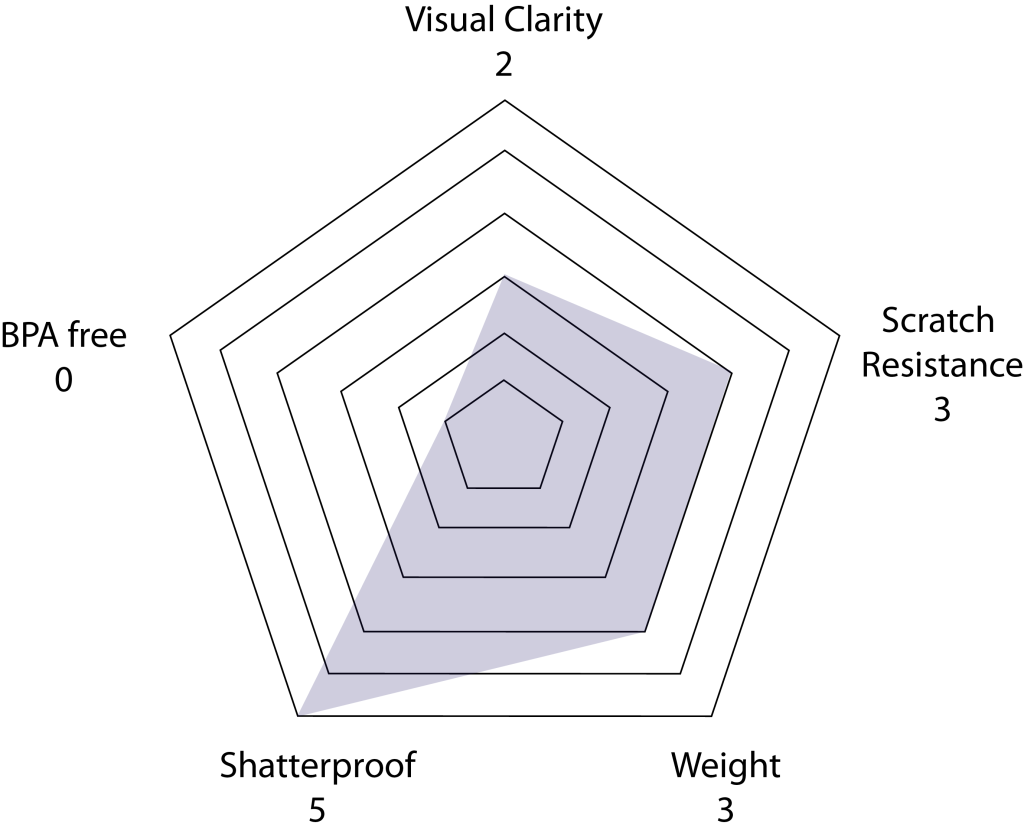
Polycarbonate has been the lens material of choice for action sports for decades and for good reason. To this day, it retains the top spot for impact resistance. It is highly suited to watersports like kitesurfing and wakeboarding.
It is a lightweight lens material with a weight of 1.20g/cm³
The scratch resistance of polycarbonate material is medium.
The refractive index of polycarbonate is 1.58
The Abbe value is 30.
Measurement Criteria
Each lens material has its own characteristics. We measure 5 key lens characteristics on a scale of 1 – 5, with 5 being the best and 1 the poorest.
• Visual Clarity •
• Scratch Resistance •
• Weight •
• Impact resistance •
• BPA rating •
Each measure is not necessarily equal in importance. They are there as reference points to allow you to consider which of the lenses is suited to you and your needs.
Nylon
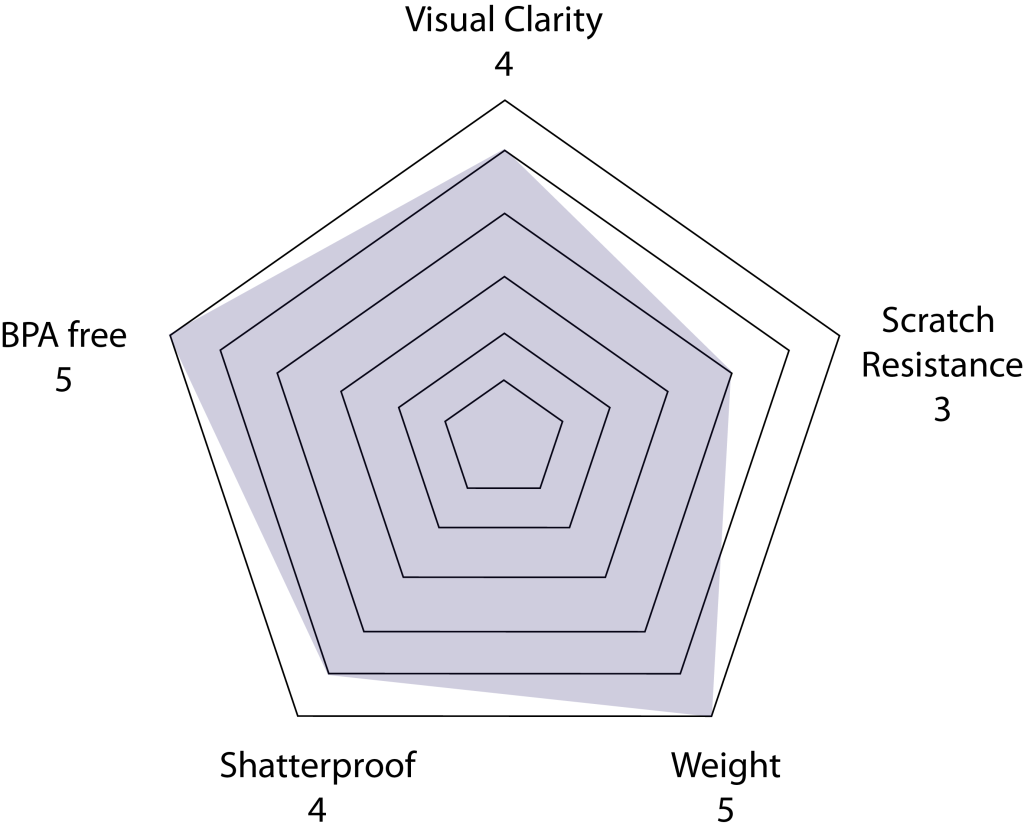
Nylon offers enhanced clarity, lighter weight and better environmental credentials than polycarbonate. The one measure on which nylon is eclipsed by polycarbonate is impact resistance, but marginally so.
Super-lightweight lens material with a weight of 1.01g/cm³
The scratch resistance of nylon material is medium.
The refractive index of nylon is 1.51
The Abbe value is 52
A QUALITY WATER REPELLENT COATING IS ESSENTIAL FOR MAINTAINING A CLEAR FOCUS
Hydrophobic Coating
All of our watersports sunglasses lenses incorporate a hydrophobic and oleophobic coating on both sides of the lenses.
A hydrophobic coating repels water whereas an oleophobic coating repels oils, sweat, dirt and dust.
The purpose of this coating is to reduce ‘water-spotting’ which will help keep your vision clear and uninhibited.
As the graphic below shows, the hydrophobic layer repels water droplets by weakening the bond of the water molecules to the lens surface.
This repellence encourages water droplets to bead together and drop away under gravity or be pushed aside by the force of the wind.
The efficiency of this coating is proportional to the cleanliness of the lens. Regularly cleaning the lenses will ensure maximum hydrophobic performance.
Tri-Pel and Ri-Pel Coatings by Zeiss
TRI-PEL: Created for watersports and used in the TYPHOON, this unique production process from Carl Zeiss Vision combines the outstanding, easy to clean, oil and water repellent features of the Ri-Pel coating, together with the technical performance of the Zeiss Tri-Flection patented mirror series. This compound surface also offers an exceptionally long-lasting anti-smudge mirror treatment.
RI-PEL: The Ri-Pel coating is the anti-smudge hydrophobic and oleophobic coating without the Tri-flection mirror coating but which can accommodate alternative mirror coatings such as Flash Pacific Blue or Multilayer Rose Gold.

Tri-Pel™ is a performance mirror that incorporates the most advanced technology of two premium coatings developed by ZEISS laboratories.
Polarization
Handling Glare
‘Glare’ or reflections of visible light from a surface like water is the loss of visual performance when too much visible light enters the eyes and the eyes are unable to adequately cope with the intensity. In a cloudless sunset, it can be extremely uncomfortable, quickly leading to irritation (redness and dryness) and eye fatigue.
We generally respond to glare by squinting or looking away. This is undesirable for fast moving watersports or if you need to maintain a strong focus. With sunglasses that do not have polarisation, it can still be blinding and this can distract you from what’s going on around you.
Polarized Lenses filter up to 99% of reflected glare
While non-polarised lenses reduce the amount of visible light reaching the eye, they will not have much impact on counteracting glare. Only polarized lenses can do this. Polarized lenses strip out up to 99% of reflected glare which will provide more clarity, comfort, and visual control on, or near, the water.

What is Polarized Light?
Light is comprised of electromagnetic waves and is generally unpolarized. Unpolarized light is the combination of a large number of these waves emitted by atoms at the light source (e.g. the sun) that are orientated in multiple directions. Each atom produces its own wave orientation and the combination of all the waves results in a superposition of waves. Unpolarized light is what is emitted from the sun, and is what we see all around us every day. Light becomes polarized when if reflects off a surface like water or snow. This means that the waves which were formerly orientated in all directions become orientated in two axes – vertically and horizontally.
The visible light that reflects off the surface of the water is orientated more horizontally than vertically, and it is this horizontally orientated light that causes the uncomfortable glare we perceive. The lens depicted in the image below has a polarization layer orientated on the Y (vertical) axis. This will strip out any horizontally orientated waves (thus filtering the glare) and allow only vertically orientated light through to the eyes.
DOWNLOAD OUR WATERSPORTS EYEWEAR GUIDE
Resources
Click the buttons below for more information



